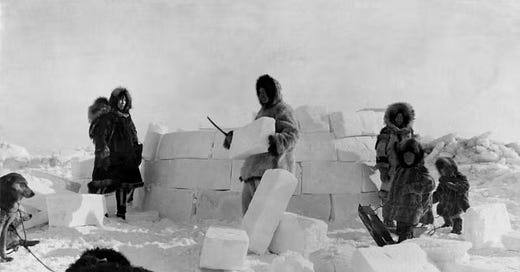“Language carves up the world in ways that reflect what matters most to its speakers.”
That insight—often stated in anthropological circles—is easy to romanticize but hard to quantify. Now, a new study led by cognitive scientists and linguists has attempted to do exactly that. Using machine analysis of over 1,500 bilingual dictionaries spanning more than 600 languages, researchers report that vocabulary is not just a passive catalog of the world, but a cultural archive shaped by what humans find urgent, beautiful, or sacred.
Published in Proceedings of the National Academy of Sciences1, the study by Khishigsuren, Regier, Vylomova, and Kemp represents one of the largest systematic efforts to test whether cultural preoccupations—like snow in the Arctic or horses in Mongolia—are etched into the lexicons of the world's languages.
“We wanted to ask not just whether Inuit languages have many words for snow,” said the team, “but whether the same patterns hold across dozens of cultures and environmental niches.”
Language as Cultural Fossil
The researchers assembled a dataset of 1,574 bilingual dictionaries between English and 616 world languages. Rather than extracting full entries (often restricted by copyright), they used word frequency metadata—how often terms appeared across definitions and example sentences—to estimate lexical density for specific concepts.
They evaluated 163 cultural concepts previously suggested in the anthropological and linguistic literature, ranging from “snow” to “love,” “horses,” “ghosts,” and “taste.” Then they ran statistical comparisons to see which languages had a higher-than-expected number of words tied to each concept.
Inuit languages, long subject to the popular “many words for snow” claim, topped the charts for snow-related vocabulary. Eastern Canadian Inuktitut, for example, includes kikalukpok (“noisy walking on hard snow”) and apingaut (“first snowfall”). The findings lend quantitative support to what had often been dismissed as folk mythology or, worse, an academic hoax.
“The idea that Eskimo-Aleut languages have an extensive snow lexicon has been derided for decades,” noted the authors. “But our analysis suggests there’s actually something to it.”
Other Arctic languages, such as Ahtena and Central Alaskan Yupik, also scored highly for snow, as did Scots, which boasts terms like doon-lay (a heavy fall of snow), feughter (a light dusting), and fuddum (drifting snow).
Beyond Stereotypes: Love, Rain, and the Smell of Fish
The researchers were equally interested in concepts beyond the Arctic tundra. Hindi showed a lexical richness around love; Japanese scored highly on obligation and duty. Mongolian, perhaps unsurprisingly, excelled in words for horses, while Oceanic languages, including Marshallese, showed exceptional vocabulary for smell.
Marshallese words include:
jatbo – “smell of damp clothing”
meļļā – “smell of blood”
aelel – “smell of fish lingering on the body or utensils”
And while snow-rich vocabularies were clustered in cold environments, rain-related language didn’t follow a neat climatic gradient. For instance, East Taa, spoken in arid parts of southern Africa, had abundant terms for rain, including ritual and metaphorical expressions such as lábe ||núu-bâ (“honorific address to thunder to bring rain”) and |qába (“ritual sprinkling to bring rain”).
“For rain, it’s not just about how much falls from the sky—it’s about how much it matters when it doesn’t,” said the authors. “People in dry regions may talk about rain more because it’s precious.”
The Perils of Quantifying Culture
Despite the scale of the analysis, the authors are cautious. Dictionary data isn’t perfect. Sometimes high word counts are inflated by the presence of example sentences or grammatical structures. For example, the top concepts for the language Plautdietsch (Mennonite Low German) included “of,” “the,” and “and”—function words that slipped through filtering mechanisms.
And there’s a broader risk: turning cultural patterns into data points can encourage oversimplified or stereotyped narratives. Words exist within systems of meaning, and context matters as much as quantity.
“This kind of work can offer insights,” the authors emphasized, “but it should never be used to essentialize or stereotype people.”
Still, the study suggests that linguistic diversity remains a rich—if sometimes messy—window into human experience. It reinforces the idea that the mind doesn’t just mirror the world—it molds it. And it leaves open intriguing questions for future work: How do children acquire these culturally rich vocabularies? How fast do they change under environmental or social pressures? What happens to culturally dense concepts in endangered or creolized languages?
As climate change, migration, and globalization reshape human lives, they may also reshape our lexicons. But for now, the words we inherit still carry the echoes of past landscapes, economies, and rituals.
Related Research
Here are some relevant and complementary studies:
Regier, T., Kemp, C., & Kay, P. (2015). Word meanings across languages support efficient communication. Cognitive Science, 39(6), 1111–1137.
https://doi.org/10.1111/cogs.12180Majid, A., & Levinson, S. C. (2011). The senses in language and culture. The Senses and Society, 6(1), 5–18.
https://doi.org/10.2752/174589311X12893982233635Everett, C. (2013). Linguistic relativity: Evidence across languages and cognitive domains. Mouton de Gruyter.
https://doi.org/10.1515/9783110347024Bohnemeyer, J., & Brown, P. (2007). Where does the linguistic system start and stop? Fieldwork and Linguistic Analysis in Indigenous Languages of the Americas.
https://hdl.handle.net/10150/225992
Khishigsuren, T., Regier, T., Vylomova, E., & Kemp, C. (2025). A computational analysis of lexical elaboration across languages. Proceedings of the National Academy of Sciences of the United States of America, 122(15), e2417304122. https://doi.org/10.1073/pnas.2417304122











Share this post